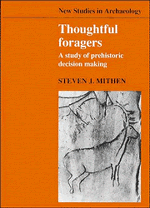Summary
In a minute there is time
For decisions and revisions which a minute will reverse
T.S. Eliot, ‘The Love Song of J. Alfred Prufrock’One of the unique characteristics of the human species is the possession of highly developed capacities for learning, decision making and problem solving, as T.S. Eliot reminds us. These result in a behavioural flexibility unparalleled in any other species. Although such capacities often require a social context for their use, they reside in the individual. Quite simply, it is these that constitute the source of cultural behaviour. It is remarkable, therefore, that archaeology, a discipline with the human species as its centre and which claims a pre-eminent role for understanding cultural behaviour, has paid scant attention to the processes of learning and decision making by individuals.
How can we gain an adequate understanding of what happened in the past, and why it happened, without making explicit reference to people taking decisions on the basis of accumulated knowledge between alternative courses of action? Certainly individual decision makers cannot be divorced from their social contexts and are part of natural communities, but it is the individual who perceives, thinks and decides. To make a flint arrowhead in one shape rather than another, to hunt deer rather than to collect molluscs, to paint rather than inscribe upon a pot are all decisions taken by individuals upon which our conception of ‘cultures’ and trajectories of social and economic change are imposed. Such decisions underlie all processes highlighted in recent archaeological thought, whether they be intensification and population pressure or core-periphery networks and peer-polity interaction. These, and other processes, are insufficiently described and understood when lacking reference to the individuals involved.
- Type
- Chapter
- Information
- Thoughtful ForagersA Study of Prehistoric Decision Making, pp. 1 - 18Publisher: Cambridge University PressPrint publication year: 1990
- 1
- Cited by

